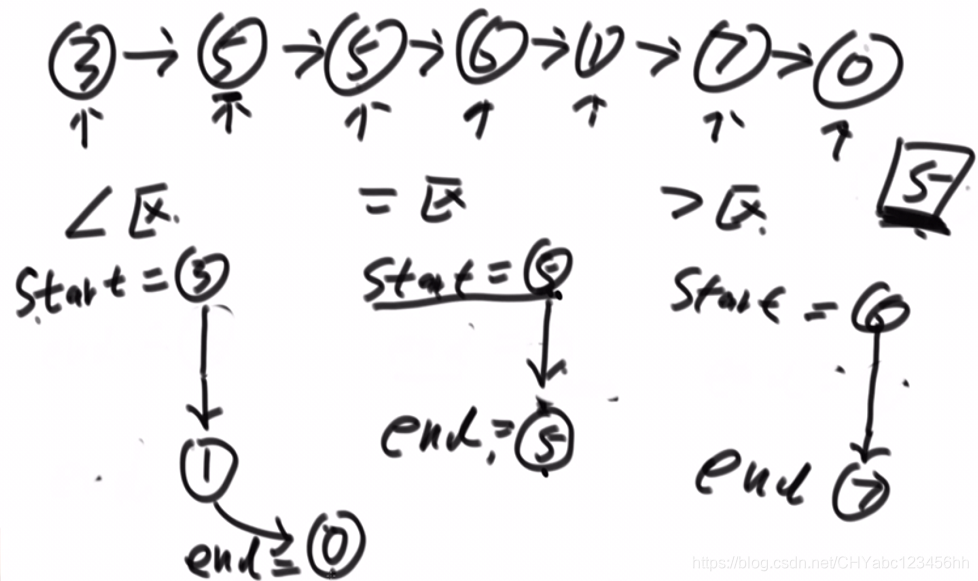牛客網 算法入門篇
判斷一個鏈表是否為回文結構
- 給定一個單鏈表的頭節點head,請判斷這個鏈表是否為回文結構
- 1->2->1,返回為True;1->2->3為False
思路:
- 1,遍歷鏈表,將所有元素壓入棧中,然后再次從頭遍歷,和棧中取出的元素比較。如果所有元素都是一致的化,說明是屬于回文結構的。
- 2,不是將所有的元素都入棧,只是將一般的元素壓入棧中,引出新的問題,如何確認鏈表的中點?設計快指針和慢指針,快指針每次移動2步,慢指針每次移動1步,當快指針移動到末尾,慢指針所指向的位置就是鏈表的中點位置。但是,鏈表長度需要分奇數和偶數。(節約空間)
- 3,不需要使用棧,僅僅使用有限幾個變量。和方法2一致,使用快慢指針找到鏈表的中點,將鏈表中點之后的元素逆序,然后逐一比較,但是需要注意的是,最后需要將鏈表變回原先的樣子。
代碼:
package class04;import java.util.Stack;public class Code04_IsPalindromeList {public static class Node {public int value;public Node next;public Node(int data) {this.value = data;}}// need n extra spacepublic static boolean isPalindrome1(Node head) {Stack<Node> stack = new Stack<Node>();Node cur = head;while (cur != null) {stack.push(cur);cur = cur.next;}while (head != null) {if (head.value != stack.pop().value) {return false;}head = head.next;}return true;}// need n/2 extra spacepublic static boolean isPalindrome2(Node head) {if (head == null || head.next == null) {return true;}Node right = head.next;Node cur = head;while (cur.next != null && cur.next.next != null) {right = right.next;cur = cur.next.next;}Stack<Node> stack = new Stack<Node>();while (right != null) {stack.push(right);right = right.next;}while (!stack.isEmpty()) {if (head.value != stack.pop().value) {return false;}head = head.next;}return true;}// need O(1) extra spacepublic static boolean isPalindrome3(Node head) {if (head == null || head.next == null) {return true;}Node n1 = head;Node n2 = head;while (n2.next != null && n2.next.next != null) { // find mid noden1 = n1.next; // n1 -> midn2 = n2.next.next; // n2 -> end}n2 = n1.next; // n2 -> right part first noden1.next = null; // mid.next -> nullNode n3 = null;while (n2 != null) { // right part convertn3 = n2.next; // n3 -> save next noden2.next = n1; // next of right node convertn1 = n2; // n1 moven2 = n3; // n2 move}n3 = n1; // n3 -> save last noden2 = head;// n2 -> left first nodeboolean res = true;while (n1 != null && n2 != null) { // check palindromeif (n1.value != n2.value) {res = false;break;}n1 = n1.next; // left to midn2 = n2.next; // right to mid}n1 = n3.next;n3.next = null;while (n1 != null) { // recover listn2 = n1.next;n1.next = n3;n3 = n1;n1 = n2;}return res;}public static void printLinkedList(Node node) {System.out.print("Linked List: ");while (node != null) {System.out.print(node.value + " ");node = node.next;}System.out.println();}public static void main(String[] args) {Node head = null;printLinkedList(head);System.out.print(isPalindrome1(head) + " | ");System.out.print(isPalindrome2(head) + " | ");System.out.println(isPalindrome3(head) + " | ");printLinkedList(head);System.out.println("=========================");head = new Node(1);printLinkedList(head);System.out.print(isPalindrome1(head) + " | ");System.out.print(isPalindrome2(head) + " | ");System.out.println(isPalindrome3(head) + " | ");printLinkedList(head);System.out.println("=========================");head = new Node(1);head.next = new Node(2);printLinkedList(head);System.out.print(isPalindrome1(head) + " | ");System.out.print(isPalindrome2(head) + " | ");System.out.println(isPalindrome3(head) + " | ");printLinkedList(head);System.out.println("=========================");head = new Node(1);head.next = new Node(1);printLinkedList(head);System.out.print(isPalindrome1(head) + " | ");System.out.print(isPalindrome2(head) + " | ");System.out.println(isPalindrome3(head) + " | ");printLinkedList(head);System.out.println("=========================");head = new Node(1);head.next = new Node(2);head.next.next = new Node(3);printLinkedList(head);System.out.print(isPalindrome1(head) + " | ");System.out.print(isPalindrome2(head) + " | ");System.out.println(isPalindrome3(head) + " | ");printLinkedList(head);System.out.println("=========================");head = new Node(1);head.next = new Node(2);head.next.next = new Node(1);printLinkedList(head);System.out.print(isPalindrome1(head) + " | ");System.out.print(isPalindrome2(head) + " | ");System.out.println(isPalindrome3(head) + " | ");printLinkedList(head);System.out.println("=========================");head = new Node(1);head.next = new Node(2);head.next.next = new Node(3);head.next.next.next = new Node(1);printLinkedList(head);System.out.print(isPalindrome1(head) + " | ");System.out.print(isPalindrome2(head) + " | ");System.out.println(isPalindrome3(head) + " | ");printLinkedList(head);System.out.println("=========================");head = new Node(1);head.next = new Node(2);head.next.next = new Node(2);head.next.next.next = new Node(1);printLinkedList(head);System.out.print(isPalindrome1(head) + " | ");System.out.print(isPalindrome2(head) + " | ");System.out.println(isPalindrome3(head) + " | ");printLinkedList(head);System.out.println("=========================");head = new Node(1);head.next = new Node(2);head.next.next = new Node(3);head.next.next.next = new Node(2);head.next.next.next.next = new Node(1);printLinkedList(head);System.out.print(isPalindrome1(head) + " | ");System.out.print(isPalindrome2(head) + " | ");System.out.println(isPalindrome3(head) + " | ");printLinkedList(head);System.out.println("=========================");}}
將單鏈表按照給定的數值,劃分成左邊小、中間相等、右邊大的形式
思路
- 1,申請一個鏈表長度大小一致的數組,然后遍歷鏈表的過程中,將每一個點放到數組容器中,在數組里面進行荷蘭國旗問題,再把數組容器中的元素都串聯起來,形成一個鏈表返回

- 2,保證穩定性:根據題目要求設置三個區,小于區、等于區和大于區,每個區間包含兩個變量,開始節點和結尾節點,一共設置6個變量,6個變量都指向null;當遇到第一個元素3的時候,它是小于指定元素5的,將小于區域的開始和結束指針都指向3;第二個元素是5,屬于等于區,讓等于區的start和end都指向第二個元素5;第3個元素也是5,讓等于區的end只想第三個元素。以此類推,得到上面的結果。最后將小于區域的end指針鏈接等于區域的start指針,等于區域的end指針鏈接大于區域的start指針。需要注意的是,有可能上面6個變量有不存在的情形,需要仔細判別。
兩個單鏈表相交的一系列問題
- 給定兩個可能有環也可能無環的單鏈表,頭節點head1和head2,實現一個函數,如果兩個鏈表相交,返回相交的第一個節點,如果不相交,返回null
- 兩個鏈表的長度之和為N,時間復雜度為O(N),額外空間復雜度為O(1)
- 相交:共用內存地址??
- 有環/無環:寫一個函數,輸入的類型是鏈表的頭節點,判斷是否有環,以及返回第一個有環的節點。使用集合來做,遍歷鏈表,每遍歷一個元素,將其放入到集合中,判定是否存在此元素,如果將一個元素放入集合中,發現他已經存在,則是有環的,并且他就是第一個入環節點。

- 使用快慢指針來做,快指針每次移動倆個位置,慢指針每次移動一個位置,當快慢指針第一次相交之后,快指針回到鏈表的起始點,慢指針呆在原地不動。然后快指針和慢指針都每次移動一個位置,當他們再次相遇之后,相遇的元素就是入環的第一個元素,且能證明這個鏈表是有環的結構。上圖所示的是環外4個點,環內4個點,可以按照這個流程走一遍。
- 兩個無環鏈表相交問題,哪個鏈表長,先走比短鏈表多余的部分,然后一起走,只要有一點的內存地址相穩合,則代表兩者相交。
- 如果一個是有環的,一個是無環的,那么他倆一定不相交

- 如果兩者都是環狀結構,那么可以劃分為上面三種形式。1,兩者都是環,都不相交;2,兩者共用環,卻已經在環外相交,入環點一樣;3,共用環,但是接入環的點不一樣。
- 第一種情形,如上圖的左邊的圖形“6”,loop1為相交點,讓loop1順著next指針走一圈,如果走了一圈沒有遇到loop2,則二者不相交。
- 第二種類型,只需要判斷二者的入環節點是否一致,就可以判定是否相交。如果需要判斷相交的第一個節點,入環點作為終止節點,轉化為先前的長短鏈,找相交點。
- 第一種情形,如上圖的右邊的圖形所示,loop1為左邊的相交點,loop2為右邊的相交點,讓loop1順著next指針走一圈,如果走了一圈遇到loop2,則二者相交。loop1 和loop2都是相交節點,只不過loop1距離鏈表1更近,loop2距離鏈表2更近。
package class04;public class Code07_FindFirstIntersectNode {public static class Node {public int value;public Node next;public Node(int data) {this.value = data;}}public static Node getIntersectNode(Node head1, Node head2) {if (head1 == null || head2 == null) {return null;}Node loop1 = getLoopNode(head1);Node loop2 = getLoopNode(head2);if (loop1 == null && loop2 == null) {return noLoop(head1, head2);}if (loop1 != null && loop2 != null) {return bothLoop(head1, loop1, head2, loop2);}return null;}// 找到鏈表第一個入環節點,如果無環,返回nullpublic static Node getLoopNode(Node head) {if (head == null || head.next == null || head.next.next == null) {return null;}Node n1 = head.next; // n1 -> slowNode n2 = head.next.next; // n2 -> fastwhile (n1 != n2) {if (n2.next == null || n2.next.next == null) {return null;}n2 = n2.next.next;n1 = n1.next;}n2 = head; // n2 -> walk again from headwhile (n1 != n2) {n1 = n1.next;n2 = n2.next;}return n1;}// 如果兩個鏈表都無環,返回第一個相交節點,如果不想交,返回nullpublic static Node noLoop(Node head1, Node head2) {if (head1 == null || head2 == null) {return null;}Node cur1 = head1;Node cur2 = head2;int n = 0;while (cur1.next != null) {n++;cur1 = cur1.next;}while (cur2.next != null) {n--;cur2 = cur2.next;}if (cur1 != cur2) {return null;}// n? :? 鏈表1長度減去鏈表2長度的值cur1 = n > 0 ? head1 : head2; // 誰長,誰的頭變成cur1cur2 = cur1 == head1 ? head2 : head1; // 誰短,誰的頭變成cur2n = Math.abs(n);while (n != 0) {n--;cur1 = cur1.next;}while (cur1 != cur2) {cur1 = cur1.next;cur2 = cur2.next;}return cur1;}// 兩個有環鏈表,返回第一個相交節點,如果不想交返回nullpublic static Node bothLoop(Node head1, Node loop1, Node head2, Node loop2) {Node cur1 = null;Node cur2 = null;if (loop1 == loop2) {cur1 = head1;cur2 = head2;int n = 0;while (cur1 != loop1) {n++;cur1 = cur1.next;}while (cur2 != loop2) {n--;cur2 = cur2.next;}cur1 = n > 0 ? head1 : head2;cur2 = cur1 == head1 ? head2 : head1;n = Math.abs(n);while (n != 0) {n--;cur1 = cur1.next;}while (cur1 != cur2) {cur1 = cur1.next;cur2 = cur2.next;}return cur1;} else {cur1 = loop1.next;while (cur1 != loop1) {if (cur1 == loop2) {return loop1;}cur1 = cur1.next;}return null;}}public static void main(String[] args) {// 1->2->3->4->5->6->7->nullNode head1 = new Node(1);head1.next = new Node(2);head1.next.next = new Node(3);head1.next.next.next = new Node(4);head1.next.next.next.next = new Node(5);head1.next.next.next.next.next = new Node(6);head1.next.next.next.next.next.next = new Node(7);// 0->9->8->6->7->nullNode head2 = new Node(0);head2.next = new Node(9);head2.next.next = new Node(8);head2.next.next.next = head1.next.next.next.next.next; // 8->6System.out.println(getIntersectNode(head1, head2).value);// 1->2->3->4->5->6->7->4...head1 = new Node(1);head1.next = new Node(2);head1.next.next = new Node(3);head1.next.next.next = new Node(4);head1.next.next.next.next = new Node(5);head1.next.next.next.next.next = new Node(6);head1.next.next.next.next.next.next = new Node(7);head1.next.next.next.next.next.next = head1.next.next.next; // 7->4// 0->9->8->2...head2 = new Node(0);head2.next = new Node(9);head2.next.next = new Node(8);head2.next.next.next = head1.next; // 8->2System.out.println(getIntersectNode(head1, head2).value);// 0->9->8->6->4->5->6..head2 = new Node(0);head2.next = new Node(9);head2.next.next = new Node(8);head2.next.next.next = head1.next.next.next.next.next; // 8->6System.out.println(getIntersectNode(head1, head2).value);}}
?





















及其相關知識的講解)
